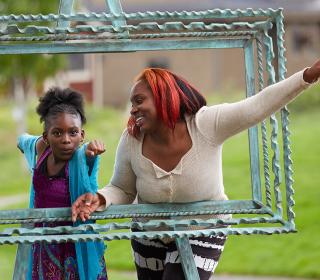When talking about racism or bigotry, most conversations revolve around overt forms, such as physical acts of violence or the use of slurs. But bias isn’t always loud and easily recognizable – because our conscious and subconscious biases influence our day to day interactions and perceptions of other people, they can also manifest in quieter ways in the form of microaggressions.
Microaggressions are indirect or subtle forms of discrimination against marginalized groups. Whether intentional or unintentional, microaggressions are products of stereotypes, misinformation, and subconscious biases, and they take many forms.
The Three Forms

Verbal microaggressions applaud or belittle people based on how they compare to imagined stereotypes. These kinds of microaggressions assume all marginalized people adhere to a set stereotype, and any variation from this imagined norm is an exception. Examples include:
- Comments like "When I look at you, I don't see color" which denies a BIPOC person's racial experience.
- Saying things like “All Asians are good at math and science,” which creates an impossible expectation where anything less than “perfect” is deemed as a failure. This stereotype also feeds into the “Model Minority” myth.
- Saying "Your English is really good!" to someone, which implies that their English should be bad solely because they’re being perceived as “foreign,” regardless of their actual nationality.

Behavioral microaggressions are actions taken based on a person’s assumptions about marginalized communities. Examples include:
- Security and shop owners following BIPOC shoppers around, assuming they're more likely to steal something than white shoppers.
- Crossing the street rather than walking on the same side of the road as a Black man. This behavior suggests that Black men are violent and threatening, which is a racist stereotype.

Environmental microaggressions create hostile spaces for marginalized people and send a message that they are unwelcome and unwanted. Examples include:
- Work events that don’t accommodate disabled employees. This makes it more difficult or impossible for disabled employees to attend events or even continue their employment at a company.
- Reluctance to give promotions or pay raises to BIPOC employees, which implies that they are less valued than their white counterparts.
- Hiring managers being less-likely to hire mothers than women without kids, working under the assumption that mothers will take more time off and won't prioritize their job.
The Three Classifications

Microassaults are intentional comments that mock and/or degrade marginalized populations because of their race, gender, sexual orientation, disability, or more. When these comments are called out, they are often brushed off as “just a joke.” Examples include:
- Calling COVID-19 “ the China Virus," which antagonizes Asian Americans and has led to fearmongering and an increase in violence against the AAPI population.
- Telling immigrant workers that they’re stealing American jobs, which perpetuates a stereotype that has no factual backing.

Microinsults are rude or insensitive actions or comments that are intentionally or unintentionally discriminatory. These comments demean a person’s identity or heritage. Examples include:
- Complimenting BIPOC individuals on their English with the assumption that they wouldn’t speak well because of their race.
- Asking someone where they’re “really” from. This question carries implicit assumptions about a person's race, nationality, and background, and it can be alienating and patronizing.

Microinvalidations are when someone discredits or tries to minimize the experience of a person from a marginalized community (often, someone who is trying to talk about their experience).
- Using the wrong pronouns for someone, invalidating their gender identity.
- Saying “they didn’t mean it like that” or “it’s not a big deal” when a marginalized person is talking about a moment where they experienced bias or racism.
- Saying “anyone can succeed in America so long as they work hard,” which perpetuates a myth that marginalized groups are just “not working hard enough” rather than acknowledging the barriers they face, like institutionalized and structural racism.
When we're able to identify why these comments or actions are harmful, it's easier for us to acknowledge and and unlearn the biases that cause them. But unlearning these biases isn't our only responsibility; when we see microaggressions take place, it's also important to know how to intervene and shut it down. Learn how you can be an ally when you are a bystander to microaggressions.
Learn more about different ways racism can manifest, and sign up for our newsletter to stay informed about YWCA’s race and social justice work.
Ana Rodriguez-Knutsen is the Content Specialist for YWCA's Marketing & Editorial team. From fiction writing to advocacy, Ana works with an intersectional mindset to uplift and amplify the voices of underrepresented communities.
We share the stories of our program participants, programs, and staff, as well as news about the agency and what’s happening in our King and Snohomish community.


